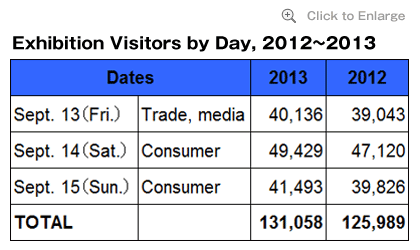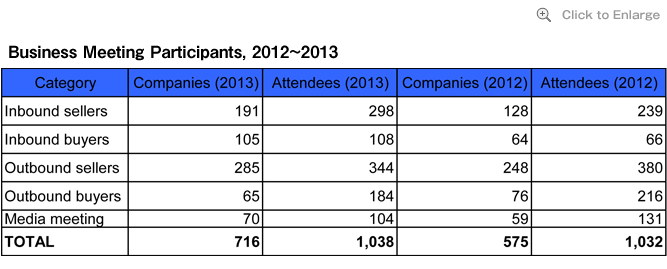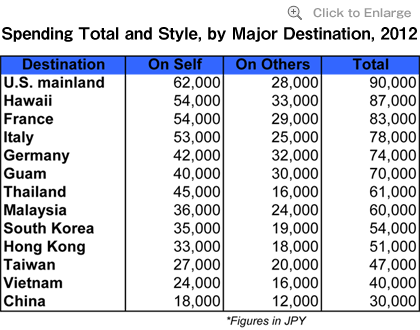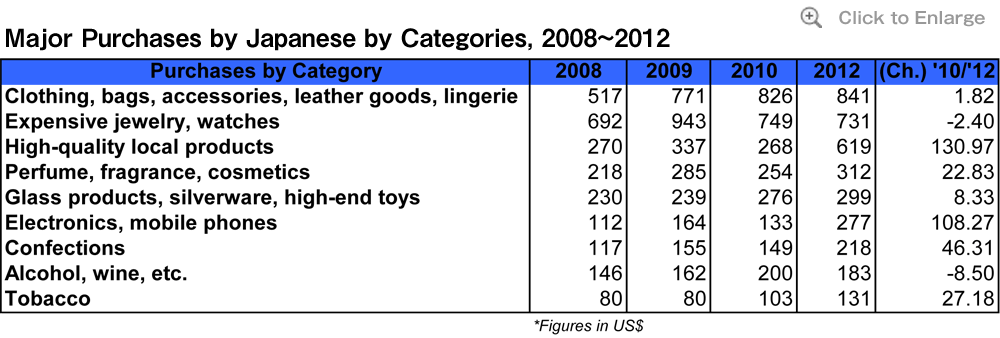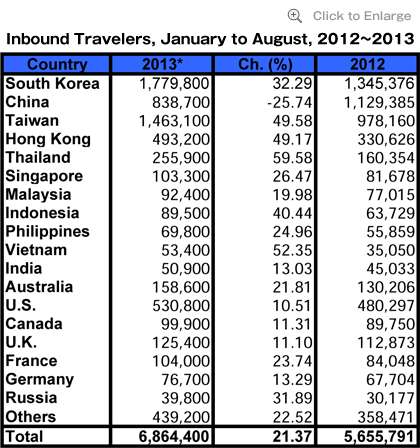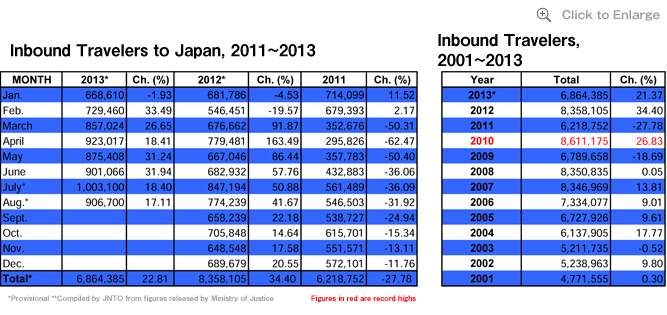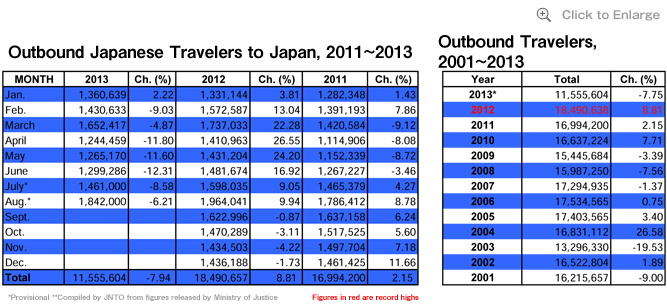Record Numbers Visit TABIHAKU Travel Show

A bird’s-eye view of the JATA Exhibition Hall
The exhibition show at JATA TABIHAKU, after three days from Sept. 13 to 15, drew a record 131,058 visitors, topping the old record of 125,989 recorded in 2012.
Despite early threats of heavy rains in the morning of Sept. 15 due to the approach of Typhoon Man-yi, the overall number underscored the rising popularity of and interest in travel, including outbound, inbound and domestic trips.
Each year since 2003 (running as JATA International Tourism Congress-World Travel Fair), the tally of visitors has risen from 91,419 to this year's 131,058.
Meanwhile, the number of exhibitors climbed to 730 from 708 in 2012, with a total of 1,353 booths, up from 1,093 a year ago, representing some 154 countries and regions.
As for the International Business Meeting (including the Media Meeting), the total number of companies reached 716, up from 575 in 2012, indicating continual interest in the Japanese travel market, with the count of attendees reaching some 1,038, slightly higher than the 1,032 a year ago.
Charity Auction Generates 2.4 Million Yen
The Tohoku Charity Auction (silent auction) at JATA TABIHAKU generated 2.4 million yen (preliminary figure only) with proceeds earmarked to benefit the recovery of the Tohoku region.
The auction, which is part of efforts by the Social Contribution Committee of JATA, last year took in 2,569,654 yen. Exhibitors, organizations and companies donated a wide range of items including luxury goods. They included items from Koaloha-brand ukulele, overseas hotel vouchers, airline tickets, gourmet food coupons, brand soccer uniforms, wines to ceramics and more.

Consumers look over products and items placed up for auction.
The number of donors reached 145, reflecting the generosity of the travel industry. The charity auction was located in a new section called TABIHAKU ICHIBA, where visitors could purchase or book tours directly from travel agents. There, visitors could also find locally available-only products and travel goods.
Within the marketplace, a “Tohoku Recovery Zone” was also set up to sell tours to the Tohoku region, Tohoku souvenirs and products to further promote the region, which was affected by the March 11, 2011 disasters.
‘TABIHAKU 2014’ Dates Set
The Japan Association of Travel Agents (JATA) has set the dates for JATA TABIHAKU Travel Showcase 2014 to run from Sept. 25 (Thurs.) to Sept. 28 (Sun.) at Tokyo BigSight.
Jungo Kikuma, JATA Chairman, said that the event will include the TABIHAKU Exhibition Show, the International Tourism Forum, the International Business Meeting and Commendations during the four days.
Starting in 1977 as JATA International Congress & Travel Trade Show to help stimulate the travel industry, the event today is Japan’s largest trade show and has grown to become one of Asia’s largest. Next year’s show will be the 25th running.
Four major components of JATA TABIHAKU 2014: the International Tourism Forum as a platform to discuss key issues, the latest trends and developments in Asia’s travel industry; the International Business Meeting, serving as a unique opportunity for sellers, buyers involved in outbound, inbound and domestic travel -- and the media -- to meet under one roof to conduct business; the Exhibition Show, which attracts more than 150 countries/regions represented by travel-related companies and organizations through their exhibition booths; and Commendations to recognize outstanding contributions toward promoting travel.
Exhibitor registration began Sept. 14, 2013, with an 8% early-bird discount provided through February 2014. Current rates will apply until April 30, 2014.
To download the forms, click the link: http://www.b.tabihaku.jp/en/download.php
Fuji TV Wins Grand Prix 2013

Fuji Television Network receives the Grand Prix 2013.
Fuji Television Network, Inc. won the JATA Tourism Award 2013 Grand Prix for its weekly show "Mezamashi TV Top of the World" program announced during the opening ceremony of the JATA TABIHAKU Travel Showcase 2013 on Sept. 13.
Fuji Television Network also won the Publicity Award.
Other winners by categories are as follow:
- Best Tourism Office Awards: Malaysia Tourism Promotion Board, Guam Visitors Bureau, Hawaii Tourism Authority, Sri Lanka Tourism Promotion Board
- Transportation Award: Princess Cruises
- Domestic and Inbound Travel Award: Okinawa Convention & Visitors Bureau, and Tohoku Tourism Promotion Organization.
Japanese Spent Most in U.S. Mainland, Hawaii: 2012 Survey
Japanese travelers dished out about US$697 per person per trip in 2012 while shopping overseas -- such as the U.S. Mainland and Hawaii, thanks to the power of the Japanese yen in 2012 -- up from the $649 figure in 2010 (no figures for 2011).
In real terms, however, the Japanese spent less in 2012 due to the buying power the Japanese currency afforded travelers compared to 2010: 56,750 yen (2010) vs. 55,620 yen (2012), according to results of the latest joint survey by Japan Tourism Marketing and Tax Free World Association.

Major annual sales in New York City attract many shoppers.
Released in May 2013, the findings revealed that Japanese spent about 90,000 yen on shopping alone in the U.S., of which 28,000 yen were for gifts for friends and family (omiyage) and 62,000 yen for themselves. Hawaii, ranked second, rang up 87,000 yen in shopping per visitor, of which 54,000 yen were for the shoppers themselves and 33,000 yen as gifts for others. France closely followed with 54,000 yen spent for the traveler and 29,000 yen on gifts.
Despite China attracting the largest number of Japanese visitors (3,518,200) in 2012, only 30,000 yen were dished on for shopping (18,000 yen for self and 12,000 yen on gifts). One explanation is the ease with which consumers can head to China, thanks to the numerous daily flights offered from major airports linking Japan to the various Chinese gateways, thus making trips to the country a frequent occurrence, similar to domestic travel. The number of air seats available on China routes in 2012 grew 29.48%, commanding a 23.93% share, compared to Hawaii's 4.66% share.
Other popular major destinations such as South Korea (54,000 yen average), Hong Kong (51,000 yen) and Taiwan (47,000 yen) each revealed lower spending levels on shopping, suggesting that Japanese travelers spent more shopping at long-haul destinations than at nearby Asian countries per trip.
A recent trend contributing to frequent travel to Asian destinations for the main purpose of shopping is on the rise, thanks to the entry of low-cost carriers in Japan.
Peach Aviation -- a Japanese LCC joint venture including All Nippon Airways -- has been successfully selling flights on the Kansai (Osaka)-Seoul route with same-day return at 7,400 yen, aimed primarily at housewives who cannot spend overnight in Seoul. The flights are seen as domestic trips for shopping jaunts as they are much cheaper than fares paid within Japan, buoyed by the strength of the Japanese yen against the Korean won.
What did Japanese travelers buy overseas? In terms of spending volume, fashion goods -- including clothing, bags, accessories, leather goods and lingerie -- ranked at the top, averaging $841 per person (67,000 yen), up 1.82% from 2010, followed by expensive jewelry and watches at $731 (58,000 yen), down 2.40%.
In terms of growth from 2010, local high-end quality products climbed 130.97% to $619 (49,300 yen), indicating strong interest among consumers in discovering unique special products available only overseas in local areas.
Electronic and mobile phones jumped 108.27% to $277 per person, thanks in large part to the popularity of Apple's iPads, iPhones and other products. Among Japanese consumers, in 2010 Apple products were ranked fifth with the Sony brand at the top. In 2012, Apple moved to the top with 37.2 points, succeeding Sony, which garnered 29.2% for second place, according to the survey.

Clothing items were popular among Japanese visitors.
Confectionary items were next, up 46.31% to $218 (17,400 yen). It was followed by perfumes, fragrances and cosmetics, ahead 23.83% to $312 (24,900 yen), largely influenced by the boom of things Korean in Japan.
Tobacco sales grew 27.18% to $131 (10,500 yen) sold at Duty Free outlets, mainly fueled by the increased taxes on cigarettes in Japan from October 2010, a development that led to the higher numbers overall.
Meanwhile, the shopping patterns between males and females show a marked gap, according to the survey findings, pointing to how women tend to shop for themselves. Overall women buy 65.4% of all items for themselves, compared to 58.3% among their male counterparts.
The shares vary depending on items purchased. Looking at women shoppers traveling to South Korea, for example, those buying made-in-Korea cosmetics spent exclusively for themselves, a share reflecting 75%. In the category of confections, 65% were for family, friends and acquaintances as "omiyage" or gifts. When it came to made-in-Korea bags, shoes, fashion wear and accessories, 34.8% said they bought for themselves, well ahead of the 13.6% who purchased for others.
Impact of Yen's Exchange Rate on Shopping
The strong exchange rate of the Japanese currency against global currencies has motivated travelers to head overseas where consumers can take advantage of their buying power. Some 28% of women in their 20s said that the stronger yen allowed them to shop more. Some 47.6% of women in this age group said that shopping was seen as a reward for themselves, while only 26.2% of men in their 20s felt shopping was a reward. Women in their 30s (45.6%) and 50s (44.7%) said shopping was a gift to themselves.
Also, 18.9% of “twenty-something” women said that the power of the yen allowed to them to splurge more often than usual.
From late last year, the Japanese yen started to weaken, diminishing the buying power of consumers heading overseas. Duty Free shops began stepping up efforts to promote not only global brands but also began displaying more local items in hopes of appealing to more travelers.
Calendar of Events
Through Oct. 8, 2013: Tokyo. An art exhibition called COLOR-HUNTING directed by Dai Fujiwara. It uses method capturing actual colors in the natural and urban environment and reproducing them on paper. At 21_21 DESIGN SIGHT in Tokyo.
http://www.2121designsight.jp/en/program/color_hunting/
Spring, Summer, Autumn 2013: Seto Inland Sea Islands. The Setouchi Triennale 2013 is a major contemporary art festival held in four islands in the Seto inland sea (Shamijima, Honjima, Awashima and Ibukijima) during three seasons, allowing visitors to experience various contemporary artwork during the different seasons of Japan. Visitors will also experience the slower place of life in the islands and the beauty that it offer. Between seasons, some art sites will remain open.
http://setouchi-artfest.jp/en/
Summer: July 20-Sept. 1, 2013 Autumn: Oct. 5-Nov. 4, 2013
Oct. 5~6, 2013: Tokyo. Harajuku Kawaii (Cute) Fes 2013. The two-day festival focuses on the cute-culture in Japan, featuring icons and musicians in street appearances and performances, including fashion shows in the streets of Harajuku.
http://fes2013.asbs.jp
Oct. 26~Nov. 4, 2013: Tokyo. Tokyo Designers Week 2013 at Meiji Jingu Gaien park and other venues in Tokyo. Considered the country’s biggest trade show at a custom-built venue designed by Kimi Hasegawa at the park. Being rebranded as a design festival rather than an exhibition, ranging from architecture to fashion to fine art.
http://www.tdwa.com/en/
Oct. 27. Tochigi. AirAsia Grand Prix of Japan in Motegi, Tochigi. It is part of the 2013 MotoGP Championship.
http://www.motogp.com/en/events/Japan/2013
Foreign Visitors on Record Pace in 2013
Some two years and five months after the massive earthquake and tsunami (and radiation threats) in Japan on March 11, 2011, inbound travel is back stronger than ever, on pace to break the all-time record set three years ago.
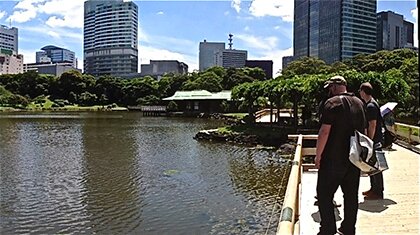
Foreign travelers visit Hamarikyu Gardens in Tokyo.
In the first eight months of 2013 through August, arrivals from abroad have reached 6,846,400, up 21.37% from a year ago and some 16.68% ahead of the record-setting count to date in 2010, according to the Japan National Tourism Organization (JNTO).
Of all the major source markets, only travelers from China are showing lower results, down 25.74% to 838,700. China has been one of the leaders in inbound travel in recent years along with South Korea and Taiwan.
So far in 2013, Thailand has become the shining star, boasting a 59.58% surge compared to the same period in 2012 to 255,900, thanks to two-way tourism promotions fueled by the weaker Japanese yen against global currencies. In 2012, some 260,859 Thais visited Japan, staying an average 17.7 days and spending 104,893 yen per person. In the first three months of 2013, the average spending per Thai visitor climbed to 111,459, according to statistics by the Japan Tourism Agency (JTA). Their rise in numbers has prompted businesses to step up Thai-language services to meet growing demand while airlines are expanding services between the two countries. THAI Smile, the LCC of Thai Airways International, will begin thrice-weekly runs on the Bangkok-Sendai run from Dec. 3 using A330-300 aircraft.
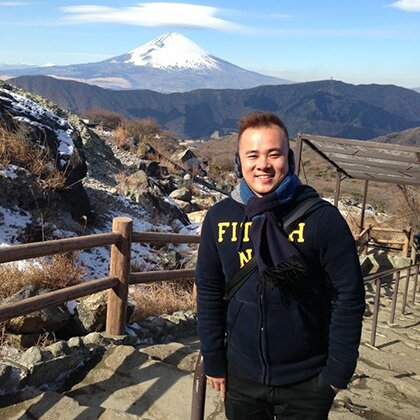
A Malaysian visitor near Mt. Fuji
Meanwhile, Malaysians, which generated a total of 130,288 arrivals in 2012, have posted a 19.98% rise to 92,400, with spending levels averaging 102,179 yen. Aside from the stronger Malaysian ringgit against the Japanese yen, the increase in services by LCCs, including those by Malaysia-based AirAsia, has stimulated demand for two-way tourism between Japan and Malaysia. Malaysia Airlines from Oct. 28 will resume direct service on the Narita/Kota Kinabalu route. In November 2010 it introduced service between Haneda Airport in Tokyo and Kota Kinabalu, a move that further supported two-way tourism.
Demand from these two markets are expected to grow even further, when the Japanese government in July started allowing visa-free waivers for visitors from Southeast Asian countries, first starting with Thailand and Malaysia.
With such changes happening, the Japanese government is eyeing the number of annual foreign visitors to reach a new high from 8.35 million in 2012 to 10.28 million this year, barring any incidents that could affect demand. By 2030, it envisions a number of 30 million visitors, a figure that would even surpass the record high of 18.49 million overseas Japanese travelers set last year.
Meanwhile, double-digit growth is seen for arrivals from key markets such as South Korea (32.29% to 1,779,800), Taiwan (49.58%, 1,463,100), Hong Kong (49.17%, 493,200), Indonesia (40.44%, 89,500) and Australia (21.81%, 158,600) for which spending per visitor averages 218,715 yen (compared to 206,537 yen in 2012), the highest of all foreign visitors. Increased traffic also is reported for the U.S. (530,800, 10.51%) and the U.K. (125,400, 11.10%).
With businesses in Japan anticipating further growth, many have introduced a wide range of services and products to further accommodate visitors in Japan, particularly high-spending ones.
Transformation of Vintage Kimono in Modern Japan
Hoping to breathe new life into the craftsmanship, beauty and art found in Japanese kimono created generations ago, Kimono Tango has been turning vintage kimono and obi into one-of-a-kind cushions and various items.
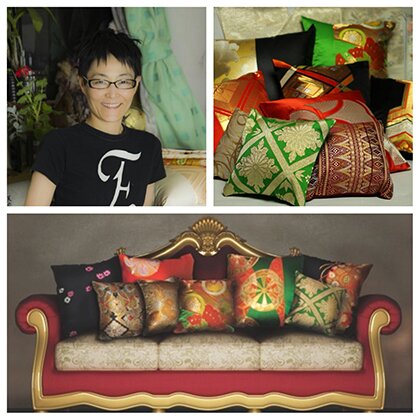
(Top left), Chizuko Takahashi, photo by Keita Shimmei; (right); customized cushions, Photo by Keita Shimmei; (bottom) photo courtesy of @HOME Magazine, Singapore
Chizuko Takahashi, founder of Kimono Tango in August 2011, said that today kimono is no longer part of everyday life among Japanese consumers, with the wear being relegated to the back of the closet or abandoned at second-hand clothing shops, after being worn a few times on special occasions. "The high cost of a kimono is a barrier, as is the difficulty of getting into one. As with other traditional clothing, the kimono is also restrictive, and you can’t move around freely. The kimono however is a work of art in itself. Today, people wear kimono only during special occasions, such as the ‘Coming of Age’ ceremonies, weddings, and perhaps funerals. It is something you wear during important events in your life."
But through Kimino Tango, Takahashi believes it can change all that and spark a renewed love for the art of kimono. "The kimono showcases Japanese artistry at its finest, celebrating designs by some of Japan’s premier artists such as Korin Ogata. Many varieties of weaves exist and each is a result of centuries of craftsmanship."
Pillow covers are seen as the best way to make optimal use of fine silk brocade without altering the original design or compromising its delicate texture, she said. "If you touch and feel the silk brocade you will know what I mean. The pillow covers add a sense of luxuriousness to your home that you can’t fabricate with mass manufactured goods. It’s one of the best ways to naturally showcase traditional Japanese art in a contemporary home."
Takahashi chooses the brocade or obi created from the late 1970s to late 1980s to be made into cushions that are priced from 7,000 yen. "This seems to be a good period since the Japanese economy was healthy and people were willing to spend more," she explained, noting that the quality of luxury items tends to improve when there is more money flowing. “Although older fabrics tend to have better craftsmanship, fabric tends to weaken over time. The problem with newer fabrics is that some of them use synthetics. It is difficult to ascertain accurately which period which obi is from."
All the cushions are one of a kind, an aspect different from products created in today’s ready-made, fast-produced world, ensuring a truly exclusive item. "What’s really wonderful is that you almost never see identical obi. The colors and designs are all unique. I will purchase anything as long as the fabric is in prime condition. So far 99% of our choices have been from Nishijin, Kyoto, but we would like to experiment with silk brocade from Niigata Prefecture and Okinawa in the future. Compared to the gorgeous silk brocades from Nishijin, these have a more restrained beauty, but these too are premium quality silk brocade that deserve another life," she emphasized.
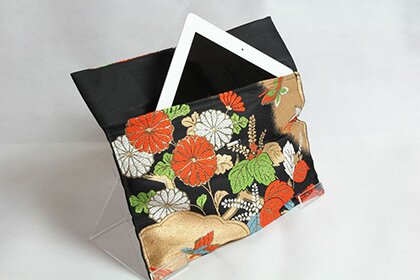
iPad case, photo by Keita Shimmei
An important element of Kimono Tango's products is in its design, which strives toward evoking a more "hip and contemporary" look to further appeal to today's discerning consumers. And while a large percentage of customers purchasing its cushions has been women between 30s and 50s, the company also has introduced a line of other products to reach a wider market: iPhone cases, iPad cases, and laptop cases that make these electrical items more cutting-edge through the blending of old with the new – something that can be described as “Cool Japan.”
Takahashi said that discussions are underway to have Kimono Tango products someday available at Takashimaya Department Store in Shinjuku, Tokyo though no timeline has been set. Products currently are sold through its website -- https://sites.google.com/site/kimonotango/ -- as well as at special events such as the American School in Japan's Winter Fest. It will participate in the American Club's International Bazaar and Asian Home Furnishings Sale on Nov. 6 and Nov. 7. It will also be in Hawaii at the Sheraton Waikiki's Holiday Craft Fair on Nov. 12.
Did You Know?
- The introduction of three low-cost carriers to Japan in 2012 – Peach, Jetstar Japan and AirAsia Japan – may still be fragile with Jetstar Japan curtailing growth and AirAsia Japan losing its founding partner, but the three are showing meaningful improvements to the Japanese economy, according to an analysis by the CAPA Center for Aviation. In the 12 months to March 31, 2013, their passenger traffic has given the Japanese domestic air market, the world's third largest, a needed bump by helping it grow for the first time since 2006.
However, it said that the situation is still dire, pointing out that 2012 was only the third year of growth since 2002, and passenger numbers in 2013 are the same as they were in 1997. "No other major market in the world -- and high-growth Asia especially -- has seen such abysmal performance." It added that international traffic fared only slightly better, with 2012 at around only 1999 levels. "And despite innovation and new best practices, load factors in the domestic market are at the same low 60% figure of two decades ago. Incumbents have signaled they must change. LCCs may force it," is emphasized.
- Demand travel among seniors remains high, becoming a driving force for both domestic and overseas travel. JTB Corp. reported that the number of seniors booking Tabisasai package tours has surged some 30% in August, with many selecting tours with business-class flights, which cost about 1 million yen.






